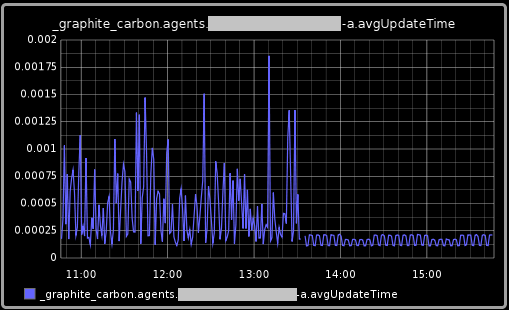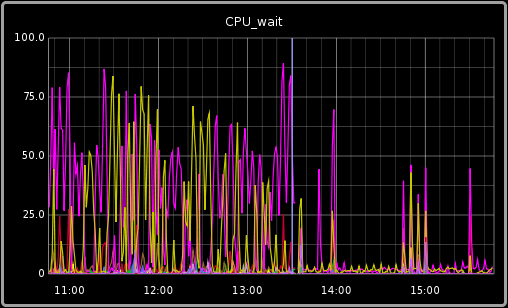Instead of buying and installing SSDs, storing Graphite’s whisper files in a memory-backed filesystem can be a good way to go if you have the RAM to spare. Depending on your environment, you may or may not care about losing a few minutes (or hours) of metric data. I know we certainly don’t care about losing 30 minutes, so there’s no reason for our carbon-cache instances to be scrawling to persistent storage 24/7.
Here’s the internal carbon Average Update Time metric showing the switch from writing to spinning disk and then memory. No shocker here:
Likewise, it’s no shocker that CPU wait time was greatly reduced. You can see me testing 5 rsyncs from memory-backed filesystem to the old spinning disk in the right of the graph:
You have 2 commonly found implementation choices for your memory-backed filesystem: tmpfs or a standard RAM disk with non-journaling filesystem applied
| tmpfs | RAM disk | |
|---|---|---|
| Create w/o reboot | yes | no |
| Resize w/o reboot | yes | no |
| Dynamically allocated | yes | no |
| Can be swapped | yes | no |
tmpfs
The Linux tmpfs implementation would look something like the following.
- Stop your carbon-cache services, then:
cd /opt/graphite/storage mv whisper whisper.permanent mkdir whisper.ephemeral ln -s ./whisper.ephemeral ./whisper echo 0 > /proc/sys/vm/swappiness mount -t tmpfs -o size=5g tmpfs /opt/graphite/storage/whisper.ephemeral
- Add the following, modified to suit, to your
/etc/rc.localor other preferred boot-time mechanism:mount -t tmpfs -o size=5g tmpfs /opt/graphite/storage/whisper.ephemeral
- One-way synchronize the persistent storage with the state of the ephemeral storage every 30 minutes:
*/30 * * * * rsync --archive /opt/graphite/storage/whisper.ephemeral/ /opt/graphite/storage/whisper.permanent
Explicit RAM disk
To implement the more predictable RAM disk setup, you would:
- Add
ramdisk_size=N(where N is the size of the RAM disk you want specified in KB) to thekernelline ingrub.conffor your distribution. Reboot. - Create a filesystem on the RAM disk device and mount it. You pointedly do not want to waste efficiency by using a journaling filesystem here, so use an
ext2filesystem and do not reserve any “minfree” space.cd /opt/graphite/storage mv whisper whisper.permanent mkdir whisper.ephemeral ln -s ./whisper.ephemeral ./whisper mkfs.ext2 -m 0 /dev/ram0 mount /dev/ram0 /opt/graphite/storage/whisper.ephemeral
- Add the following, modified to suit, to your
/etc/rc.localor other preferred boot-time mechanism:mkfs.ext2 -m 0 /dev/ram0 mount /dev/ram0 /opt/graphite/storage/whisper.ephemeral
- One-way synchronize the persistent storage with the state of the ephemeral storage every 30 minutes:
*/30 * * * * rsync --archive /opt/graphite/storage/whisper.ephemeral/ /opt/graphite/storage/whisper.permanent
As always, I welcome your thoughts.

